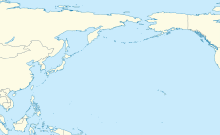
Incheon International Airport is the main international airport serving Seoul, the capital of South Korea. It is also one of the largest and busiest airports in the world.

Gimpo International Airport, formerly rendered in English as Kimpo International Airport, is located in the far western end of Seoul, some 15 km (9 mi) west of the Central District of Seoul. Gimpo was the main international airport for Seoul and South Korea before being replaced by Incheon International Airport in 2001. It now functions as Seoul's secondary airport. In 2015, over 23 million passengers used the airport, making it the third-largest airport in Korea, as it has been surpassed by Jeju International Airport.

Gimhae International Airport is located on the western end of Busan, South Korea. Opened in 1976, the airport is named after the nearby city of Gimhae. A new international terminal opened on October 31, 2007. Gimhae International Airport is the main hub for Air Busan, and a focus city for Jeju Air, Jin Air and Korean Air. Runway 18L/36R is used for military purposes only for Gimhae Air Base, but due to increasing traffic, there are plans to open the runway for airliners. In 2018, 17,064,613 passengers used the airport.

Fukuoka Airport, formerly known as Itazuke Air Base, is an international and domestic airport located 1.6 NM east of Hakata Station in Hakata-ku, Fukuoka, Japan. The facility has one 2,800 m (9,186 ft) runway and covers 355 hectares of land.

Jeju International Airport is the second-largest airport in South Korea, just behind Incheon Airport in Incheon. It is located in the city of Jeju. The airport opened in 1968.

Da Nang International Airport is an international airport serving the area of Central Vietnam and the region's largest city Da Nang. It is the third international airport in the country, after Noi Bai International Airport (Hanoi) and Tan Son Nhat International Airport.

Cam Ranh International Airport is located on Cam Ranh Bay in Cam Ranh, a provincial city in Khánh Hòa province in Vietnam. It serves the city of Nha Trang, the capital of Khánh Hòa province, which is 30 km (16 NM) from the airport. This airport handled 9,747,172 passengers in 2019, making it the fourth busiest airport in Vietnam, after the ones in Ho Chi Minh City, Hanoi and Da Nang, and one of the fastest growing airports in the country.
Gunsan Airport is an airport serving Gunsan, a city in the North Jeolla Province in South Korea. In 2019, 306,518 passengers used the airport. It shares its runway with Kunsan Air Base, which uses the same IATA and ICAO codes. Because Gunsan Airport is sharing with military, taking photograph or video of apron, runway and military facility is strictly prohibited.

Yeosu Airport is an airport in Yeosu, South Jeolla Province, South Korea. In 2018, 590,112 passengers used the airport.

Muan International Airport is an international airport in Muan County, South Jeolla Province, South Korea. Construction of the airport began in 1997 and the airport opened on November 9, 2007. The airport serves the province of South Jeolla, especially the cities of Gwangju, Mokpo and Naju. It replaced the nearby Mokpo Airport and is expected to replace the nearby Gwangju Airport in the near future as well. In 2018, 543,247 passengers used the airport. The airport is managed by the Korea Airports Corporation.
Jin Air Co., Ltd. is a South Korean low-cost airline. As of April 2018 it operates flights to six domestic cities and 26 international destinations. It launched its first long haul route, between Incheon and Honolulu, in December 2015. It has operated cargo services since November 2013. Jin Air is the first widebody LCC operator in Korea.

Eastar Jet is a South Korean low-cost airline with its headquarters in Banghwa-dong, Gangseo-gu, Seoul. On January 7, 2009, Eastar Jet made its maiden flight from Gimpo International Airport to Jeju International Airport. Now, the airline operates a scheduled passenger network to 14 destinations in eight countries. Its main base is Gimpo International Airport, with a hub at Jeju International Airport.
Air Busan Co., Ltd., operating as Air Busan is a low-cost airline based in Busanjin-gu, Busan, South Korea. It is a subsidiary of Asiana Airlines. The airline began its operation in 2007 as Busan International Airlines Company ; it launched service in October 2008.

T'way Air Co., Ltd., formerly Hansung Airlines, is a South Korean low-cost airline based in Seongsu-dong, Seongdong-gu, Seoul, South Korea. As of 2019, it was the third largest Korean low-cost carrier in the international market, having carried 2.9 million domestic passengers and 4.2 million international passengers in 2018. Its international traffic had quadrupled in the three years leading up to 2019.
Air Incheon (Korean: 에어인천) is a South Korean cargo airline with its base at Incheon International Airport near Seoul. It serves five scheduled cargo destinations from its base in Seoul.
Air Seoul (Korean: 에어서울) is a South Korean low-cost carrier and a subsidiary of Asiana Airlines. The airline is based at Incheon International Airport just outside of Seoul, from which it operates flights to international destinations. It launched operations on 11 July 2016.
Fly Gangwon was a short-lived South Korean low-cost airline which was founded in 2016 and made its maiden flight on 22 November 2019 from Yangyang to Jeju. The company slogan was Fly To Your Dream. On 19 May 2023 the airline ceased all flight operations and filed for bankruptcy protection.
Aero K Airlines Co., Ltd. is a low-cost airline based in South Korea. It was founded in 2016 and received its first aircraft in 2021. The name is derived from spelling "Korea" backwards.














